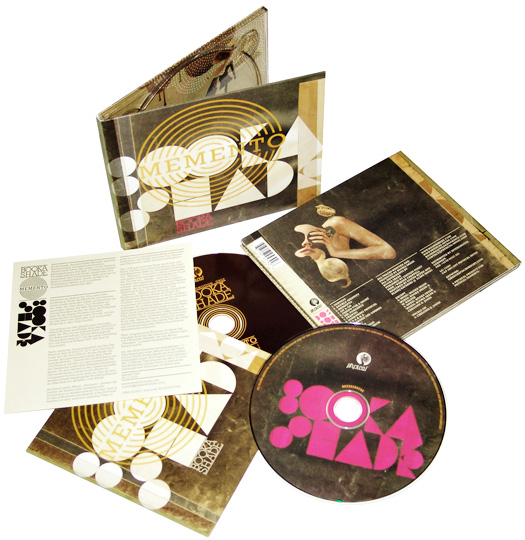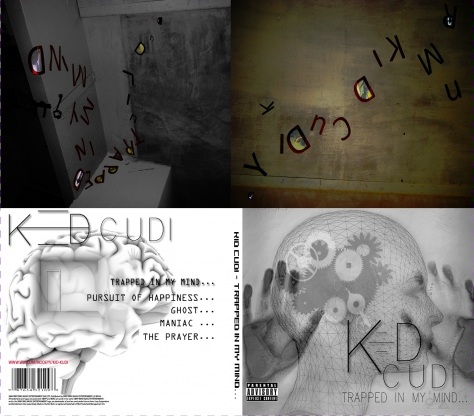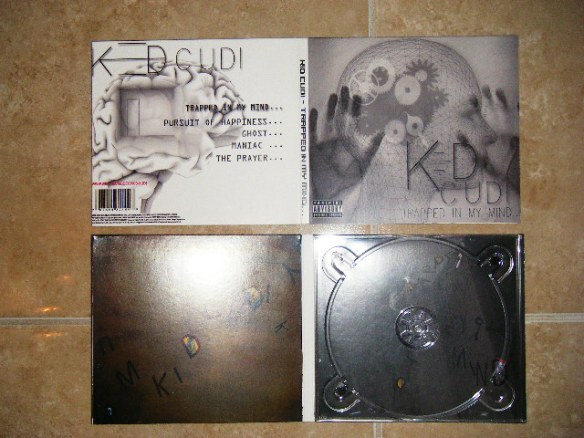QUESTION ONE/IN WHAT WAYS DOES YOUR MUSIC VIDEO USE, DEVELOP OR CHALLENGE THE FORMS AND CONVENTIONS OF MUSIC VIDEO/PROMO PACKAGES?
It almost impossible to say what the conventions of a music video are because they have varied and developed tremendously over the years. However I believe that our final music video can be classed as an actual music video, as we have worked extremely hard to challenge the forms and conventions of a real music video to make sure it fits well to the categories requirements. In order to do this we have applied certain conventions of music videos and other media forms and technologies, as a result of this it has enabled us to create our own unique music video to Kid Cudi ‘Trapped in my mind’.
Throughout the making of our final media product we have challenged and developed certain music conventions such as;
- Synaesthesia
- Narrative & Performance
- Disjuncture & Illustration
- Camera shots/movement/angles
- Cutting/editing/ fast & montage
- The Meat (or star image)
- Beats!
- Lighting & Colour
- Mise-en-scene.
Stop Motion:
Throughout our coursework this year, we have been able to base our initial music video idea around the technique of stop motion, illustration and artistic movements. As mentioned in the research and planning stages of my coursework, stop motion is an animation technique to make a physically manipulated object appear to move on its own. The object is moved in small steps between individually photographed frames, creating the illusion of movement when the series of frames is played as a continuous sequence.
Our music video has challenged the forms of stop motion, and the forms of stop motion in music video in the first scene. Our opening introduction shot is composed entirely from 43 printed letters, all of which move by themselves within the contexts of stop motion around our desired room.
Synthesis/Narrative & Performance:
Synaesthesia is possibly one of the most important aspects of a music video as it works on the basics of building up visuals to a soundtrack. Whilst, allowing the viewer to create their own interpretation of sounds, taking into consideration the way they introduce a certain or mood. Due to the lack of performance in our final media product, we have decided to focus the aspect of synthesis around the sounds and the lyrics used in Kid Cudi’s soundtrack. For example we listened to the key sounds, tempo’s and structure of the song and managed to associate these beats during our music video. This allowed; the audience to associate the tempo of the song to the moving letter print out during the introduction scene. Also allowing the songs structure to enforce the visual images/loose narrative of our final music video.
In terms of narrative and performance we challenged the forms and conventions of music video through using our previous research and planning, to build a solid structure to our narrative. During the research stage, I studied Kid Cudi’s video for ‘Pursuit of Happiness’ to get a general feel of narrative and performance within the genre of Alternative rap that his music category falls in. The research stage has taught me the following points about narrative and performance;
- Close up’s of the objects in the video – central focus.
- Subtle links to the lyrics, possible links to objects in particular.
- Due to the genre – we could make the narrative horror linked.
- Overall generally set a depressing mood within the video!
In order to challenge the conventions of narrative within the alternative rap genre of Kid Cudi, our music video used the same technical aspects of narrative that are used in that genre, aspects such as;
- Various objects that were purposely placed in the video for product placement purposes.
- Objects that we could use for visual associations to the narrative.
- Close ups of the objects and facial expressions in the video.
- Most importantly we kept the narrative attention grabbing due to the depressing and negative mood.
- Although we did not incorporate any performance we have made the narrative extremely interesting and mind puzzling.
Sometimes music videos are completely abstract, with visual images apparently unconnected to the artist or the lyrics. This is called disjuncture videos.
Disjuncture/Illustration:
Disjuncture type of videos ofter explores a concept, very loosely based on the lyrics.
Camera Shots/Angles/Movements:
In terms of Camera shots, I based my initial thoughts and ideas on the way that directors from Kid Cudi’s existing music videos used camera shots in the construction of videos like “pursuit of happiness” and the camera work used in a recent piece of work “no one believes me”
In order for our music video to challenge the conventions within the genre of electro/pop, we used a range of camera shots;
> Establishing shots(ES) – such as the start of Trapped in my mind – these shots established where we have set the video in the main scenes
> Mid Shots (MS) – These aided the establishing shots – It gives a larger view of the performance given, however in our video it gives a larger detail of the frame and the narrative.
> Close ups (CU) – These shots were the most important shots in our video – these shots gave our target audience a close up view of the moving photos and facial expression – allowing them to see the detail of the lettering as they move. Whilst the close ups in the face highlights expressions of the emotions and confusion Dom is experiencing in each room he appears in.
> Extreme Close Ups (ECU) – Extreme close helped to aid the audience in understanding the narrative – it also enabled us to pick out the fine detail through using the cameras and other available technologies.
> Camera movement on the other hand, we will be using simple methods that will allow us to follow the photos accordingly when filming the first scene and make the other scenes smooth together frequently.
> Panning & Zooming – to change setting and cover space – In Kid Cudi’s existing videos the director constantly zooms out to capture more of the scene within the frame. In our video it gave some variation of camera movement and gave a larger picture of the trapped room where the scene is set, allowing the audience to follow the moving letters and sentences around the confined room.
> Camera Tilt – tilting to various angles using the tripod allowed us to follow the actor’s movements as it was important to give the illusion that Kid Cudi is trying to escape but failing which adds confusion. Therefore to make sure our music video wasn’t too confusing and un relevant, we needed to use technical camera movements like the tilts.
Montage Editing:
Music videos rely heavily on montage editing with a wide variety of different footage juxtaposed etc. Live footage cuts to close-ups of singer’s face to show the expression and mood cutting to footage of the actor self harming or kicking off at random objects, etc. All showing that many random shots are repeating after each other constantly. We used this form of editing well in our music video throughout interesting narrative, as our narrative helps gather a variety of locations and then we have linked them together whilst still making sense and following the narrative, allowing us to have ‘freedom’ in our music video. This was a very clever thing to do as it allowed us to be much more artistic and creative without ideas, if something didn’t work then we had the ability to change the idea, which was a bit like a trial and error experiment.
When it comes to the speed of our editing we relied on the tempo and mood of the song, which then helped us develop the slow tempo and emotions of the soundtrack creating longer lasting shots. Developing upon this idea we used slow motion within a few of our scenes, one example would be what Dom Bennett slowly and painfully punches the door. This helped us use editing techniques to slow down the scenes with the tempo of the music. When it comes to the time management of the music within in the video and making them synchronise together perfectly we thought it would be a good idea to use cuts with the beat of the song by adding Gaussian Blur to the editing,. This successfully created a blur/fuzz every time there was a large beat taking place, matching the song whilst also adding movement to the music video. At the end of the day John Fiske quoted “music videos foreground the signifier over the signified” meaning that music videos are more based on the aesthetics than the narrative.
DIGIPACK:
Our final digipack which I strongly believe is a very unique and inspiring cover due to the strong influence of the lyrics within the soundtrack. As the name of the song is called ‘Trapped in my mind’ I wanted to represent the mind of a person who might be trapped and the damaging thoughts that might be occurring within the mind. This matches well with our music video and the song as it creates a strong sense of claustrophobia. When it came to designing the covers of the digipack we did try to challenge the conventions of albums arts, but using more illustrative work than having the main focus being the singer. The singer is only shown once the package has been opened which challenges some unusual convention of the artist being as its not been directly focused on. However we did include the most important aspects of a successful digipack and inserted bar codes and copyright acts on the back of the album artwork to show the institutional connects of our album, preventing people from copying our design work.
Existing cover artwork (Demonstrated more clearly on album artwork research)
As you can see from this digiback collection, this artist has used photo manipulation and some sort of illustrative aspect to this design. Which makes it look very eye catching and doesn’t have any photograph of the main artist. This was something that I was aiming at when in the design stages. I felt that the most effective album artwork are designs that show more creativity and thought. Therefore when I began to design the digipack I made sure I could show that I have use media technologies like Photoshop and other photo manipulating software that would enable me to create an artist piece of work.
Our final cover artwork.
Above is our completed digi-pack view on the computer before it was sent off too Fuzz Digital printers.
This is the final printed digi-pack which had finally arrived back from Fuzz Digital. I am extremely proud with our product, as it was the first time I’ve have designed something which actually got published in bulk. Unexpectedly we received 10 hard copies of our digi-pack, meaning each member of the group could take one home to be proud off.



